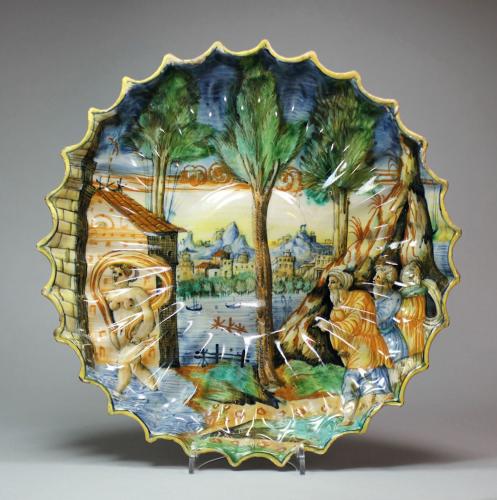
This object is eligible for a Certificate of BADA Provenance
The BADA Standard
- Since 1918, BADA has been the leading association for the antiques and fine art trade
- Members are elected for their knowledge, integrity and quality of stock
- Our clients are protected by BADA’s code of conduct
- Our dealers’ membership is reviewed and renewed annually
- Bada.org is a non-profit site: clients deal directly with members and they pay no hidden fees
Hispano-Moresque plate, Valencia (Manises), 16th century, the decoration divided into two main sections, one with sprouting foliage and large stylised flowerheads against a ground with leaves and dots, the other with a segment of floral lattice-style design, patterned bands and two flowerheads, the reverse with multiple concentric circles.
Diameter: 21 cm. (8 1/4in.)
Notes:
Designs incorporating birds and plants were popular choices for the Moorish potters in Spain who made Hispano-Moresque ware. Although early designs are more overtly Islamic, and can include inscriptions in Arabic and symbols such as the tree of life, the huge popularity of these wares and their increased production for wider consumption across Europe led to a fusion of Islamic and European design elements. The beautiful lustre effect is achieved by applying a tin glaze over a design traced in cobalt blue before the first firing, then brushing on a metallic pigment on top of the tin glaze before a second firing. This technique was perfected by Islamic potters; in part because the use of vessels made from precious metals at mealtimes was prohibited by the Hadiths (the record of the saying of the Prophet Muhammad).
Production was initially centred around Malaga in Southern Spain, which remained under Muslim rule until 1487. However, over the course of the fifteenth century, the migration of potters northwards led to the development of other production centres in and around Valencia, including a large concentration of workshops in Manises. Manises had an abundance of natural resources including clay and a special sand used to make glazes, and produced high quality wares which enjoyed the patronage of some of the wealthiest nobles, such as Maria of Castile, Queen of Aragon, who ordered a large service of Manises ware in 1454.
Dimensions
Diameter: 21 cm. (8 1/4in.)Stock number
W738The BADA Standard
- Since 1918, BADA has been the leading association for the antiques and fine art trade
- Members are elected for their knowledge, integrity and quality of stock
- Our clients are protected by BADA’s code of conduct
- Our dealers’ membership is reviewed and renewed annually
- Bada.org is a non-profit site: clients deal directly with members and they pay no hidden fees


